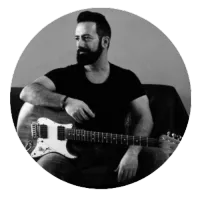Elite Guitar Coaching Academy Blog
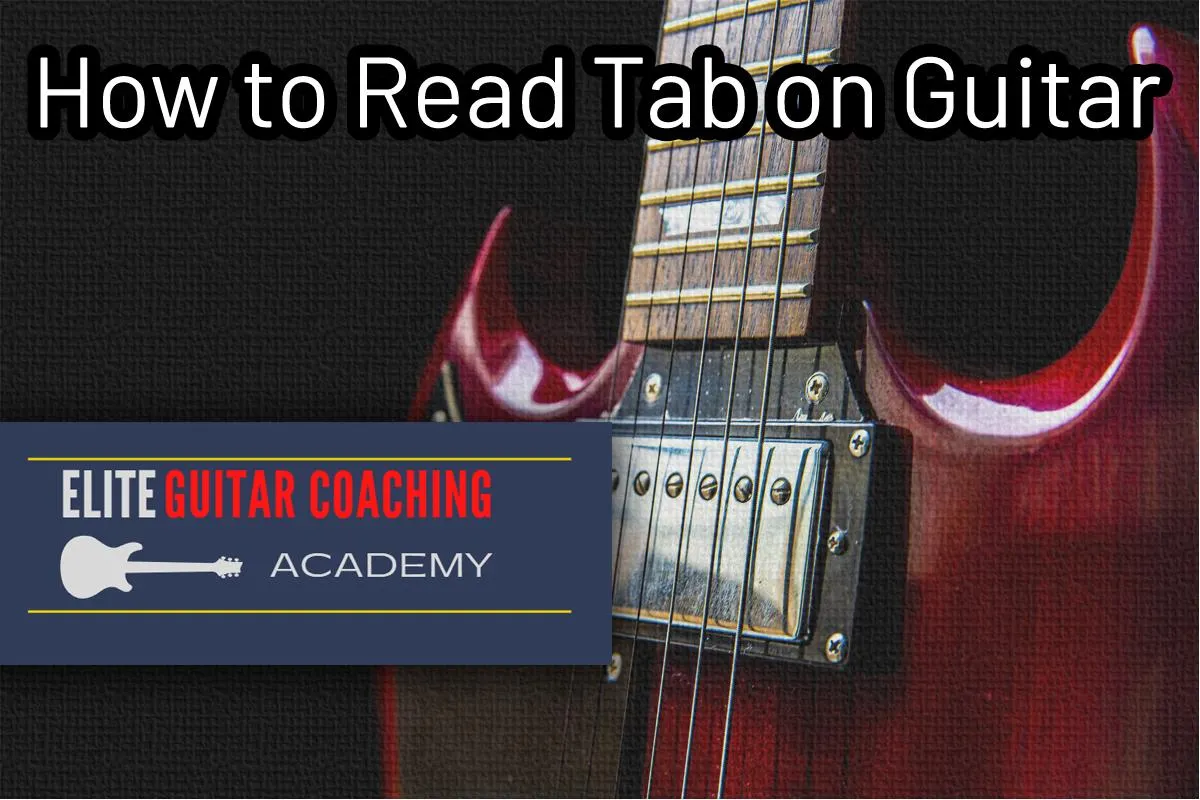
How to Read Tab on Guitar
With easy-to-follow instructions and helpful tips, you’ll learn how to read tab on guitar, so you can start playing your favorite songs.
"Guitar tab" is a way to write down music for guitar players, and it helps beginners learn songs quickly and easily. It looks a bit like regular music notes, showing you which notes to play and how long to play them. But the best part is that it also tells you where to put your fingers on the guitar! This is really helpful for beginners because the guitar has lots of places to play the same notes. So, if you're just starting to learn guitar, learning how to Read Tab on Guitar tab will make it easier for you to play your favorite songs without needing to learn how to read traditional music notes.
At the Elite Guitar Coaching Academy, we teach students how to Read Tab on Guitar. This is a way to learn your favorite songs quickly and easily. Guitar tabs show you which strings and frets to play, so you don't need any special knowledge. It's like following a map to find the right notes and chords!
So, let’s get started!
What is a guitar tablature?
Guitar tablature is a picture that shows you which notes to play in a song. To make a guitar tab, we use six horizontal lines that represent the six strings on the guitar. The top line shows the thinnest string (called the high E), and the other lines show the other strings in order, from the next thinnest to the thickest (called the low E).
This is like looking down at your guitar while you play it. Guitar tab is like a map that shows you the best way to play a song. It's like having directions that will help you learn the song faster!
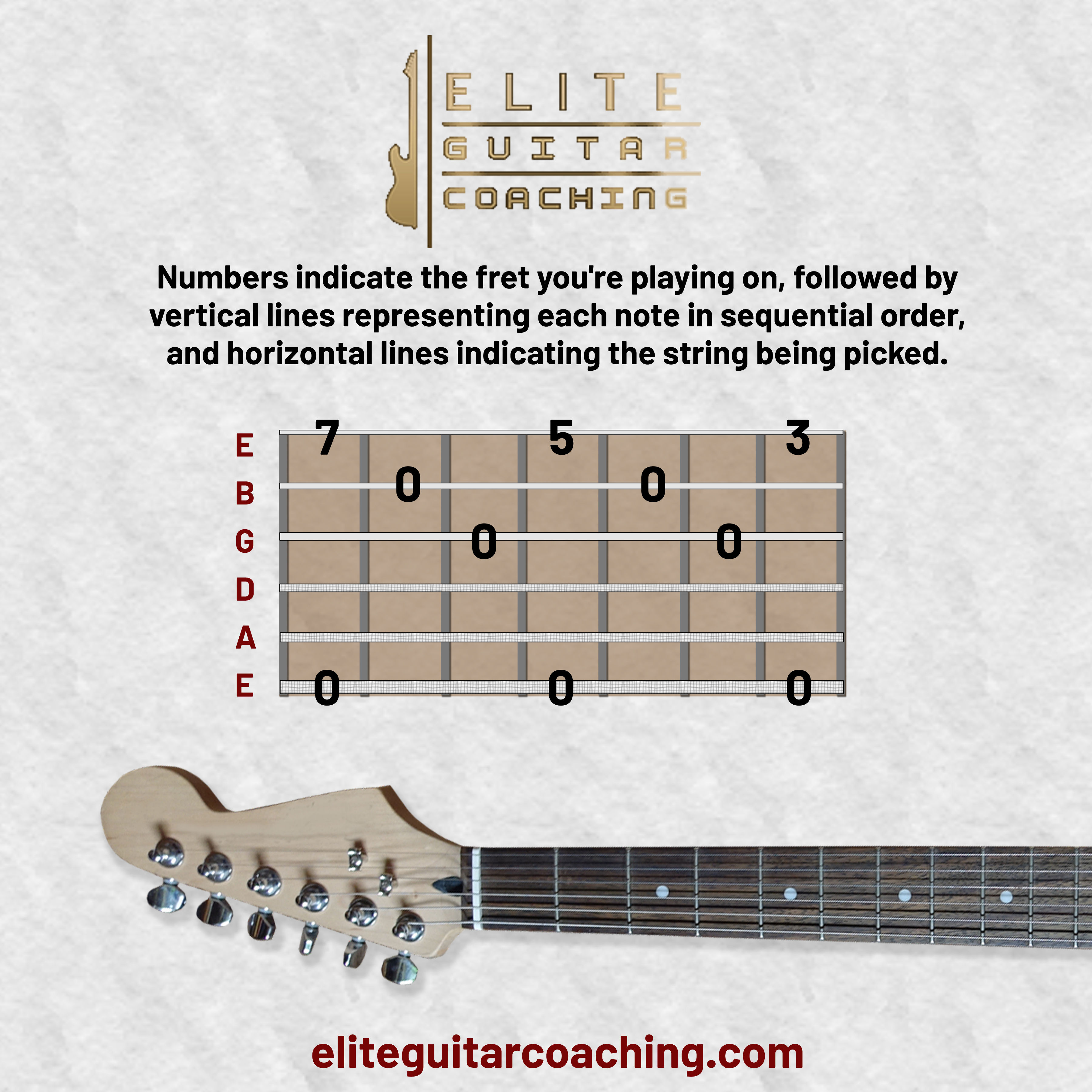
When you look at a line of guitar tablature, you will see some numbers. These numbers tell you which frets to press down on your guitar. Frets are the metal strips you find on the long part of the guitar, called the neck. They are numbered from 0 to 22 or 24, and they start at the top of the guitar, near the head, and go all the way down to the bottom.
How to Read Tab in Guitar
In the guitar tablature, the order of the strings goes from top to bottom like this:
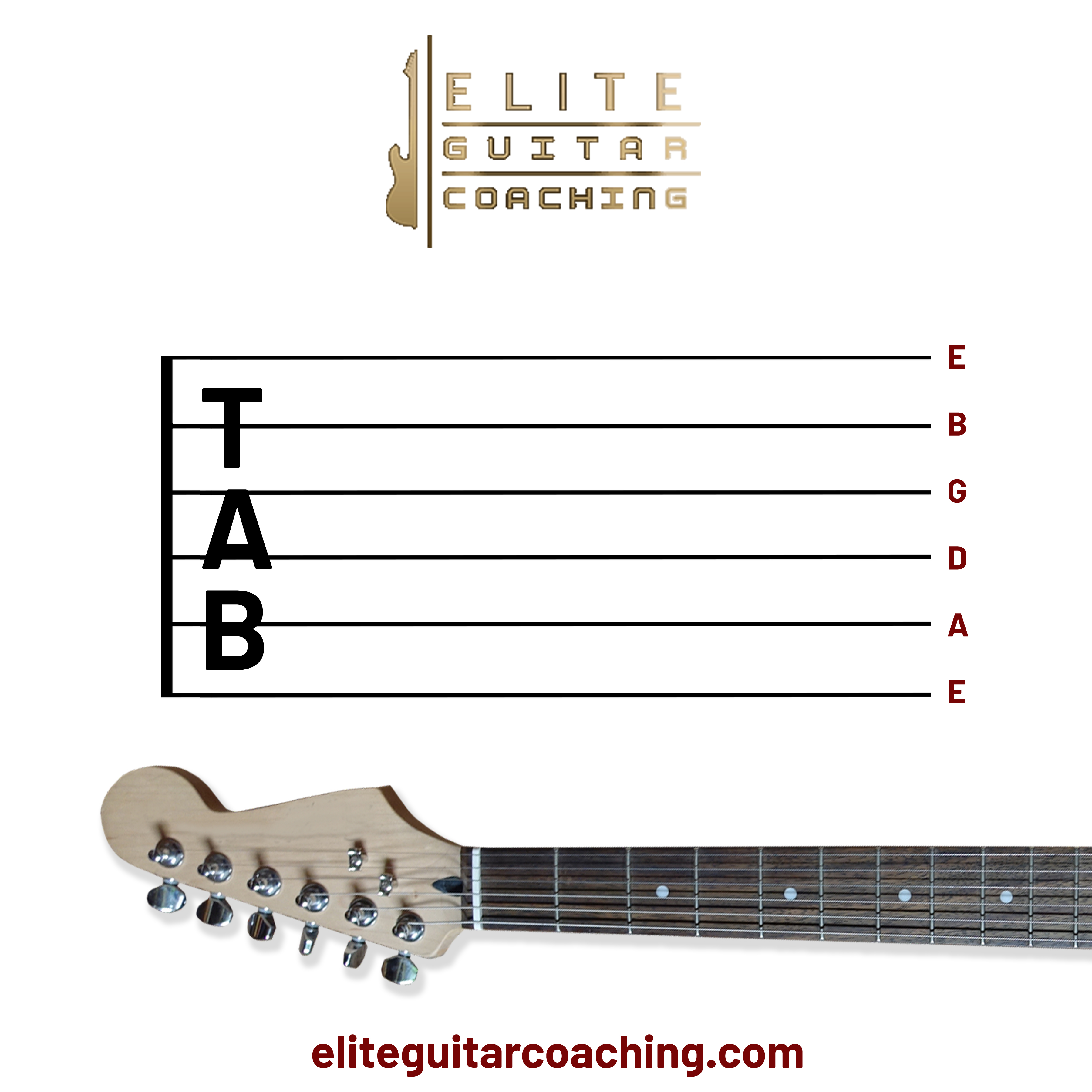
The bottom line of the guitar tablature shows the thickest and lowest string, which is called the low E. The top line shows the thinnest and highest string, which is called the high E. The other strings are in between, just like on the guitar itself.
Next to each string on the tab, you will see a number. This number tells you which fret to press down on that string. Here is an example:
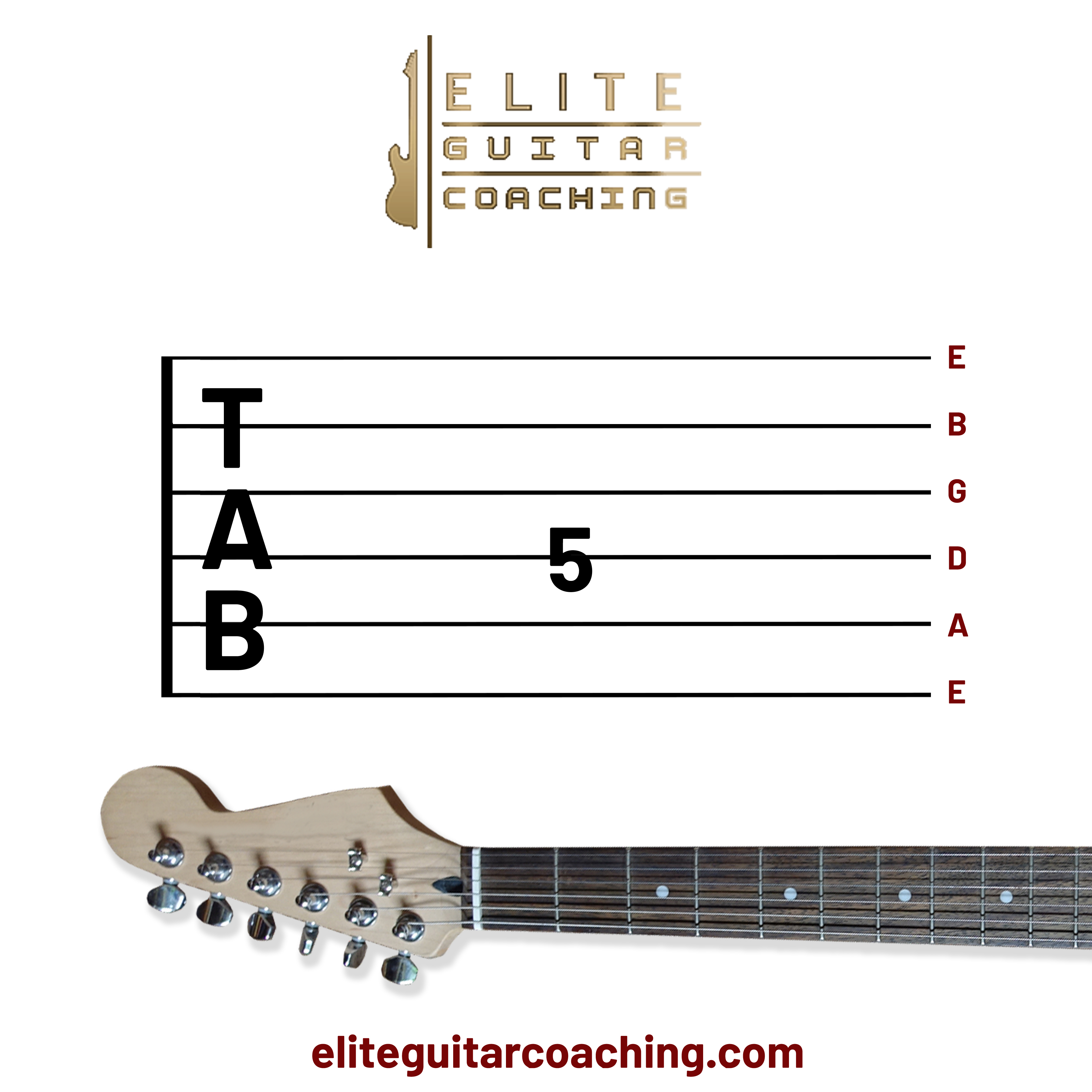
Let's use the example shown in the guitar tab. To play this, you should use your left hand to press down on the fifth fret of the D string, and then use your right hand to pluck that string.
When you see other numbers in a row, it means you should play each note one after the other. Here is an example:
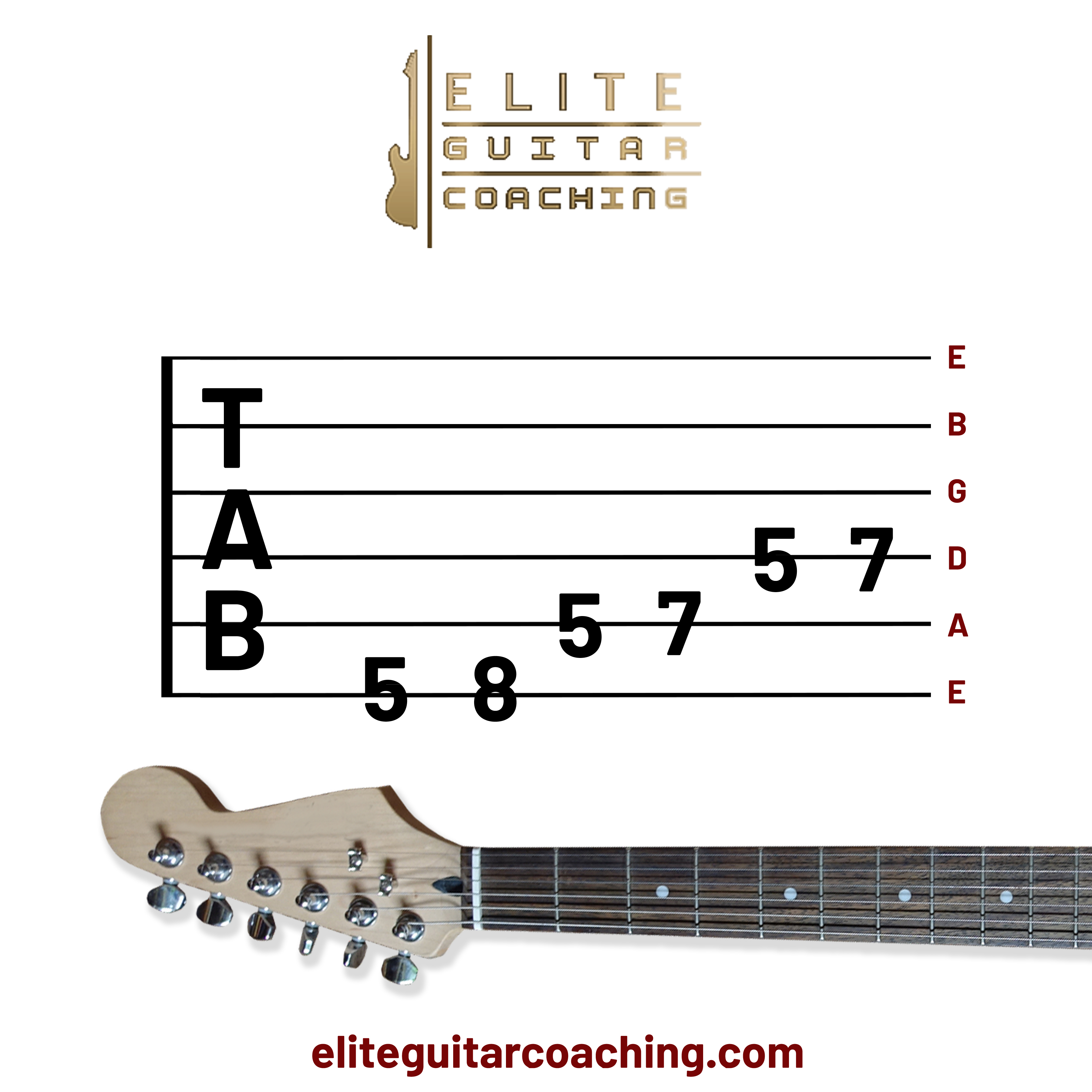
Note: when you see the number zero, it means you should play that string without pressing down on any frets. Here is an example:
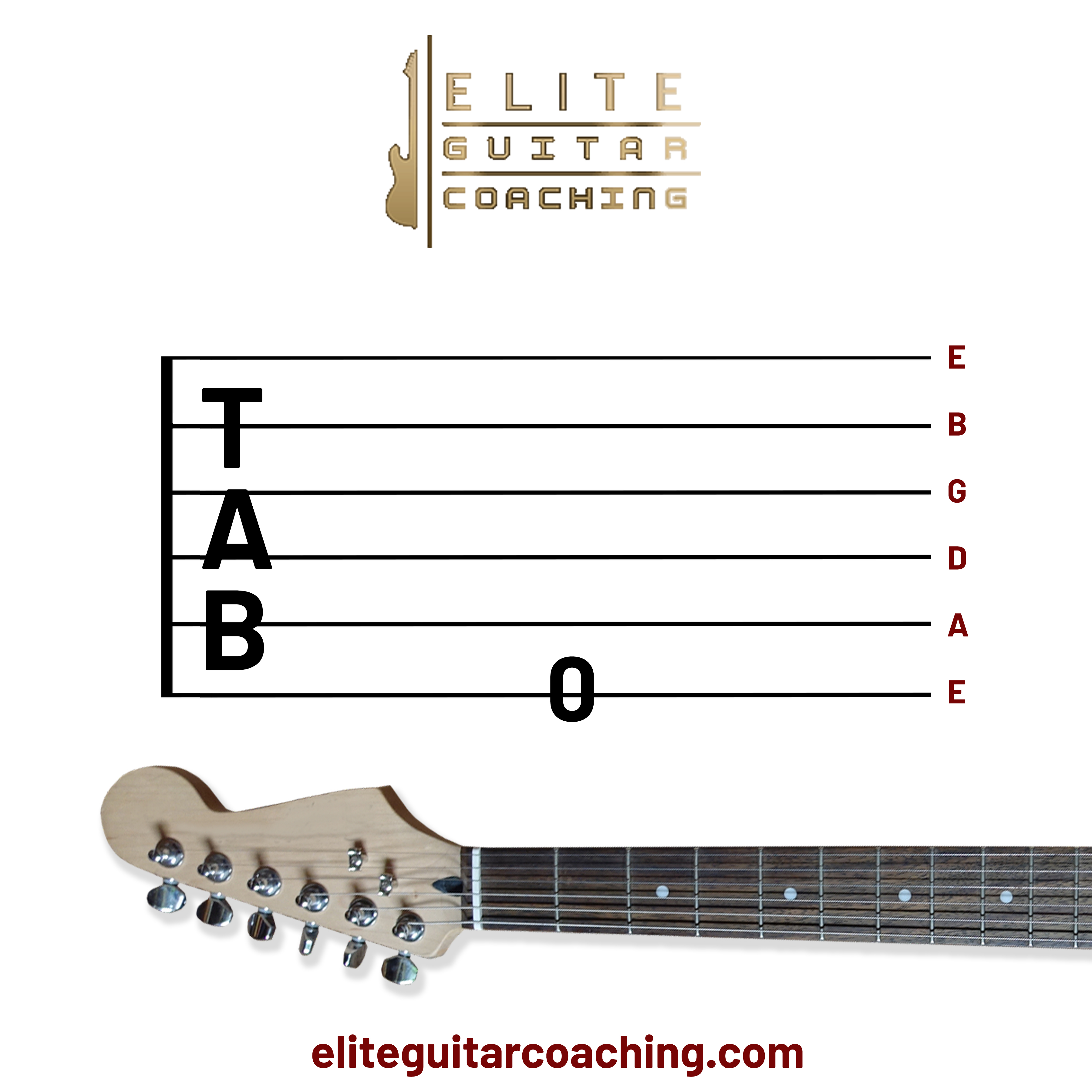
When you see numbers stacked on top of each other in the guitar tab, it means you should play those notes at the same time. Here is an example:
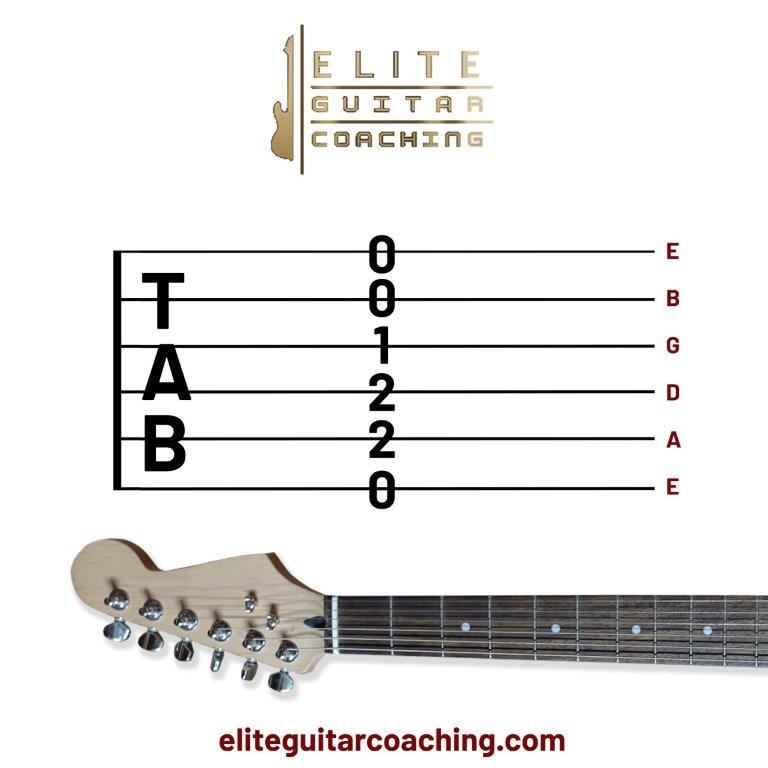
This is how we show chords in the guitar tablature. If a string doesn't have a number on it at a particular moment, it means you shouldn't play that string at that time.
How to Read Tab on Guitar: Technique symbols explained
Guitar tablature may contain various symbols, in addition to lines and numbers, that signify the timing of specific techniques. Developing the ability to interpret and utilize these symbols will enhance the authenticity of your playing and simplify the process of reading guitar tabs.
Bending
To bend a string in guitar tab, beginners should look for a curved arrow situated over the desired note to be played. The arrow indicates whether the bend is a half or full step, which will result in the string's pitch being raised by one or two notes. These raised notes are referred to as "target" notes.
PERFORMING STRING BENDING ON GUITAR
To execute a bend, you need to “push” the string up or down, instead of pressing it straight down on the fretboard. With the exception of the low E string, players tend to push the strings towards the ceiling to accomplish the bend. Meanwhile, the low E string requires downward pressure towards the floor. The key to successfully bending a string is to maintain even, constant pressure while executing the technique.
STRING BENDING TECHNIQUE
For the majority of bends, two or three fingers are utilized: the "main" fretting finger (usually the ring finger), along with the index and middle fingers to provide added support and strength. This technique results in smoother and easier bends, as well as greater control over the pitch of the note.
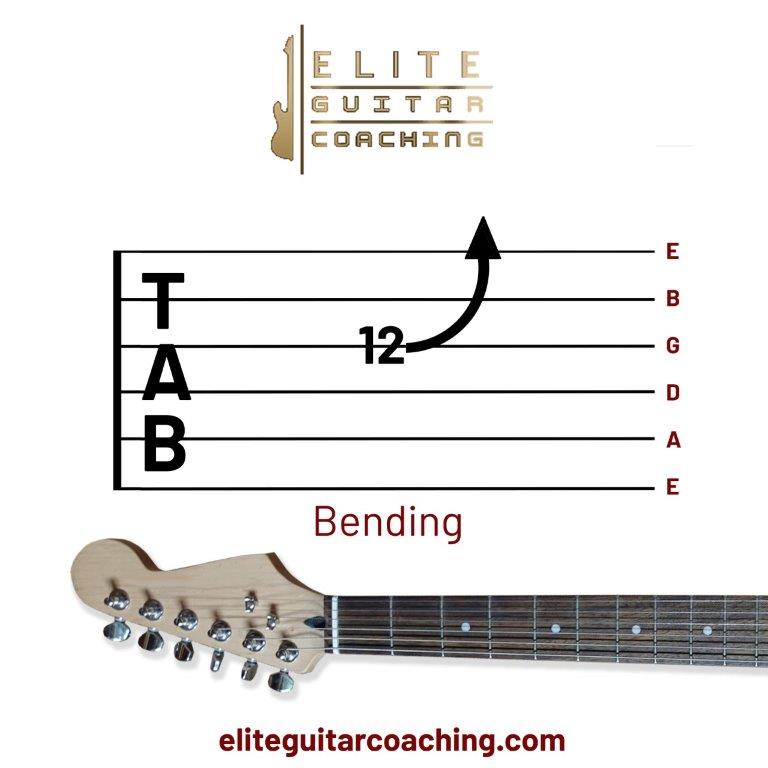
PRE-BENDING
Now, when you read guitar tab, they may come across the term "pre-bend." Pre-bending involves bending the guitar strings prior to picking them, and then releasing them to return to the pitch of the original fretted note. A pre-bend is indicated on the tab by an upward arrow denoting the extent of the bend (full, half, etc.), followed by a downward curved arrow. The pre-bent note may either return to the original pitch or be bent further up to reach a different target note.
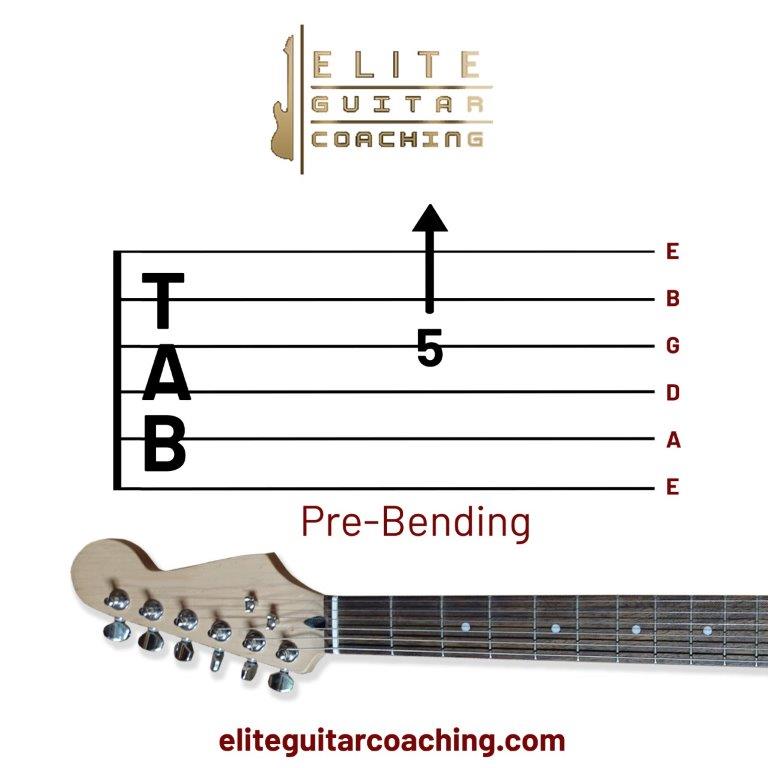
Muting
The implementation of muting techniques is crucial in Rock music, with various styles such as Heavy Metal and Punk relying on them to achieve a particular sound or character. Muting guitar notes is a valuable skill that adds dynamic to your playing, with guitarists utilizing these techniques unconsciously while performing. Muting is especially useful during verses to create contrast with the chorus or hook. When playing on stage, muting helps prevent unwanted noise or feedback.
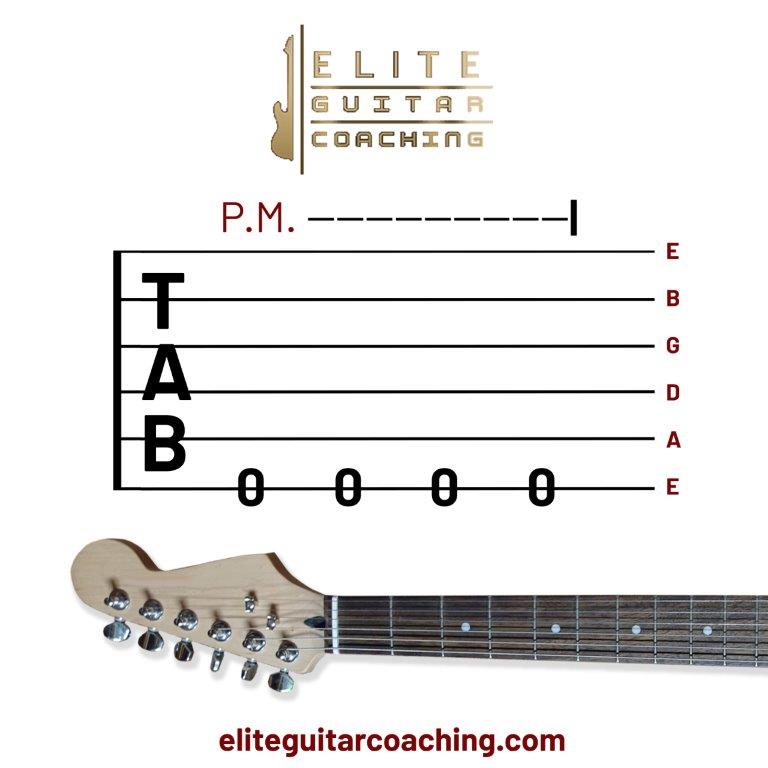
Muted Notes
Muting notes on a guitar involves a distinct approach from palm muting, and it involves utilizing your fretting hand. While the notes are still plucked in guitar tab, they are not audibly pronounced as the fretting hand applies less pressure on the fretboard. In guitar tablature, this is denoted by an "X" symbol in place of the usual fret number.
Hammer-ons
To perform a hammer on, exert sufficient pressure on the fretting finger to make the string sound, instead of plucking it. It may require some practice to achieve a distinct and robust note. It's also more effortless to execute on an electric guitar at a moderate volume. Begin by hammering on the third fret of the open low G string and sustaining the note for its full duration. Then, replicate this process on various frets and strings.
On the tab, you'll see an "H" letter accompanied by an arc linking the notes, denoting the hammer-on.
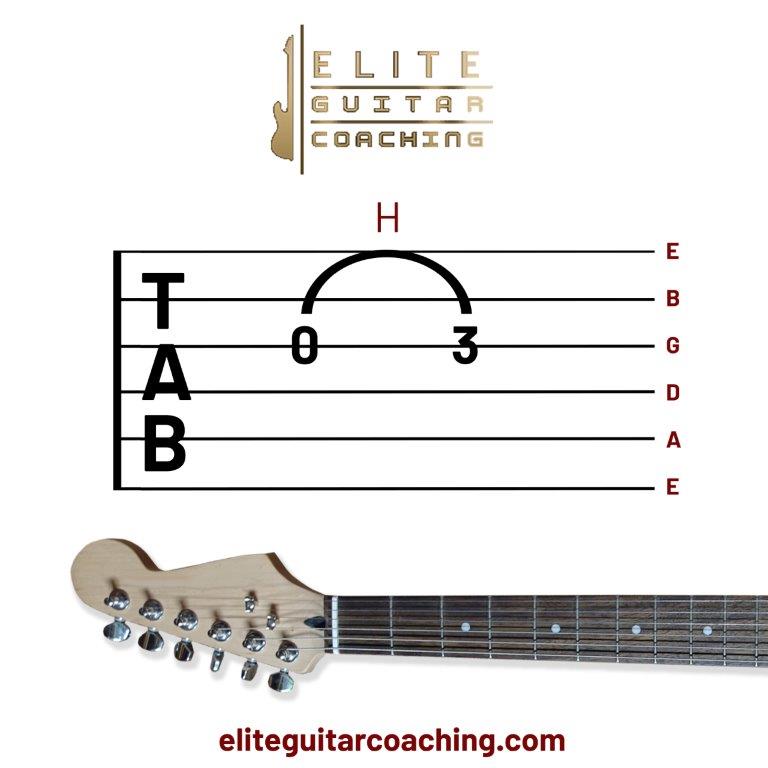
Pull-off
In order to perform a pull off on the guitar, you need to press down on the note and then release it, producing a lower-pitched open or fretted note. The act of pulling off requires you to grasp enough of the string with your fingertip to create a sound.
If you alternate between performing hammer ons and pull offs, you can create a combination of the two techniques, commonly known as a "trill."
Tapping
The widely used technique of tapping in guitar playing involves fretting notes with your dominant fretting hand and simultaneously tapping or fretting notes with the index finger of your non-dominant picking hand. The tapping motion with the picking hand is essentially a type of hammer on.
To represent tapping in guitar tablature, a letter "T" is placed above the note that is to be tapped.
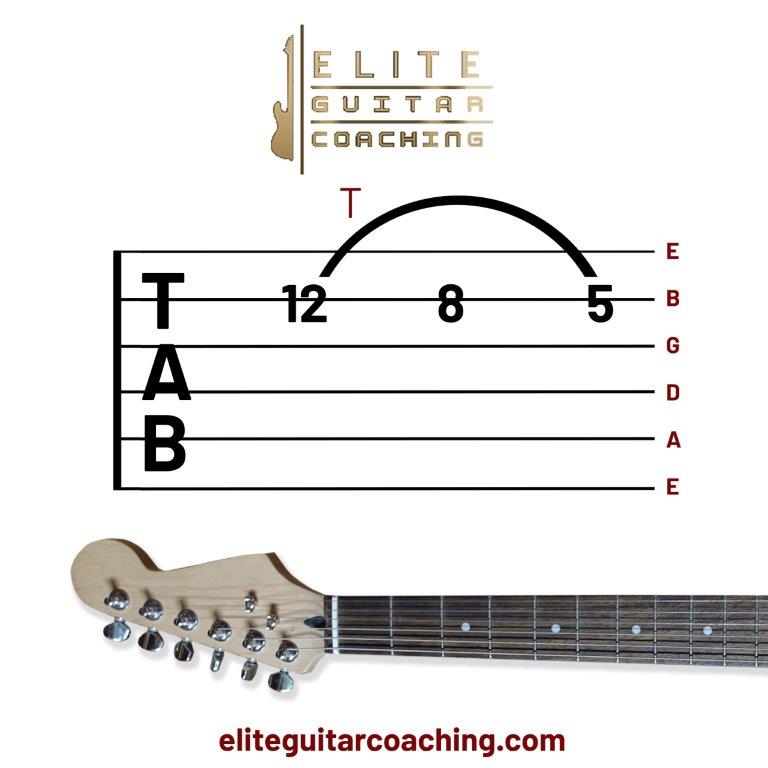
Vibrato
Vibrato and bending are closely related techniques, although vibrato does not alter the pitch to the same degree as bending. Vibrato can be executed by either using a single finger or using one main finger in combination with others for support. It's advisable to begin with a slow, steady vibrato and then adjust the speed to achieve distinct outcomes. Similar to bending, vibrato can produce a singing quality to soloing, and each guitarist's vibrato is unique and personal, akin to a fingerprint.
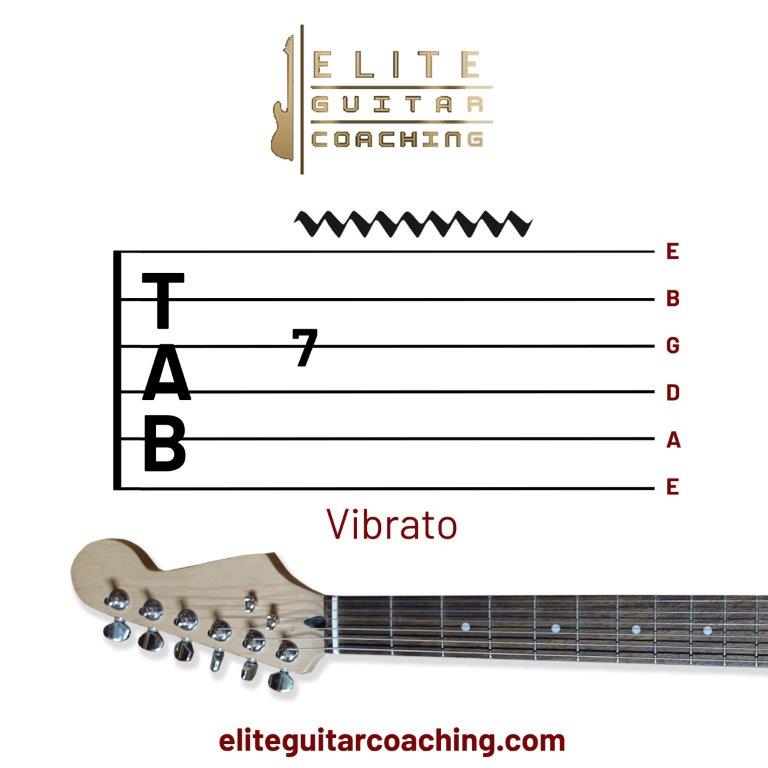
Strumming
There are two ways to stroke chords on a guitar: upstrokes and downstrokes.
Downstrokes
When using downstrokes, the motion is downward, starting from the lower strings and ending on the higher strings. This is represented in guitar tab by a symbol with a thick horizontal line and two downward-facing legs.
Upstrokes
Conversely, upstrokes begin on the high strings and end on the low strings, using an upward motion. This is denoted in guitar tab by a "V" shape.
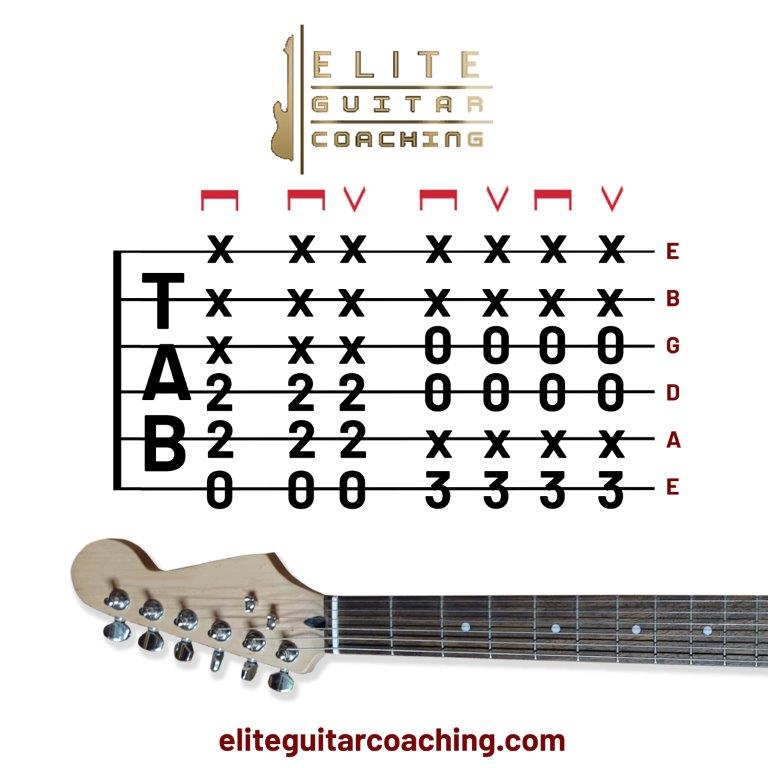
Sliding
In sliding you can slide your fretting finger up or down to the next note, which is different from bending. When sliding up, there will be a line indicated between the note you are sliding from and the note you are sliding to, and if the note you are sliding to is higher, the line will go up slightly. Conversely, when sliding down, there will also be a line indicated between the note you are sliding from and the note you are sliding to, but if the note you are sliding to is lower, the line will go down slightly.
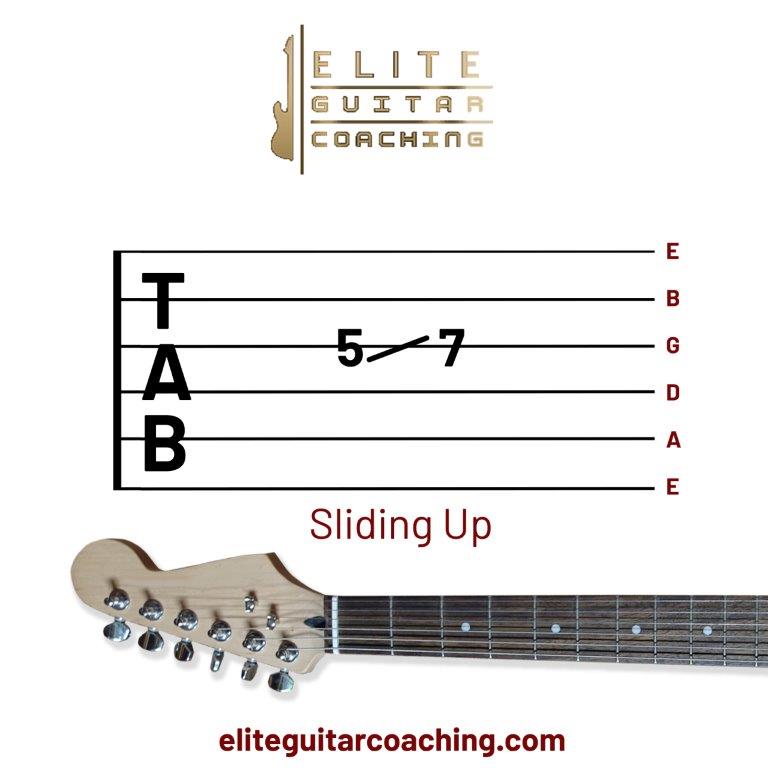
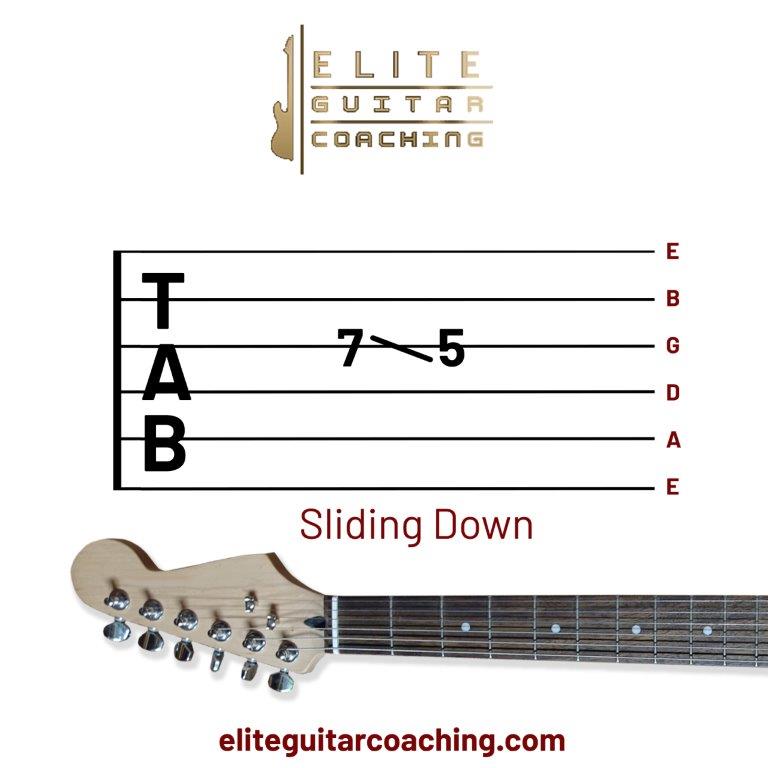
Now that you have learned the basics on how to Read Tab on Guitar, it is advisable for all musicians to have knowledge of sheet music in addition to tablature, as the latter does not convey the timing and rhythm of the music. Although tablature may include some timing notations, it is not as commonly used.
I suggest that guitarists and musicians in general do not solely rely on tablature unless they are a beginner in music, in which case they should dedicate more time to practicing with tablature and gaining familiarity with their instrument's fretboard. This will facilitate a more effective and expedited learning process when transitioning to sheet music.
Congratulations on learning how to read tab on guitar! Ready to take your skills to the next level? Discover how to master the minor scale in record time here.
I hope this was helpful. If you’re interested in developing your guitar skills and reaching your music goals, please check the different Elite Guitar Coaching Academy packages and how you can get private coaching from me.
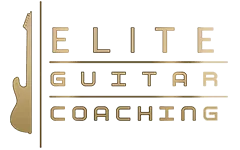
© Copyright - Elite Guitar Coaching Academy. All Rights Reserved - Privacy Policy - Earnings Disclaimer - Terms & Conditions
Earnings and income representations made by Elite Guitar Coaching Academy, eliteguitarcoaching.com, are aspirational statements only of your earnings potential. The success of Elite Guitar Coaching Academy testimonials and other examples used are exceptional, non-typical results and are not intended to be and are not a guarantee that you or others will achieve the same results. Individual results will always vary and yours will depend entirely on your individual capacity, work ethic, business skills and experience, level of motivation, diligence in sticking to Elite Guitar Coaching Academy's guidance and strategies, the economy, the normal and unforeseen risks of doing business, and other factors.
Elite Guitar Coaching Academy, and eliteguitarcoaching.com individually, are not responsible for your actions. You are solely responsible for your own moves and decisions and the evaluation and use of our products and services should be based on your own due diligence. You agree that Elite Guitar Coaching Academy is not liable to you in any way for your results in using our products and services. See our Terms & Conditions for our full disclaimer of liability and other restrictions.
Do you have questions? Are you wondering if this will work for you? Email us at info@mg.eliteguitarcoaching.com
We will be happy to discuss your goals and how our courses, coaching or consulting services may help you. Thank you.

